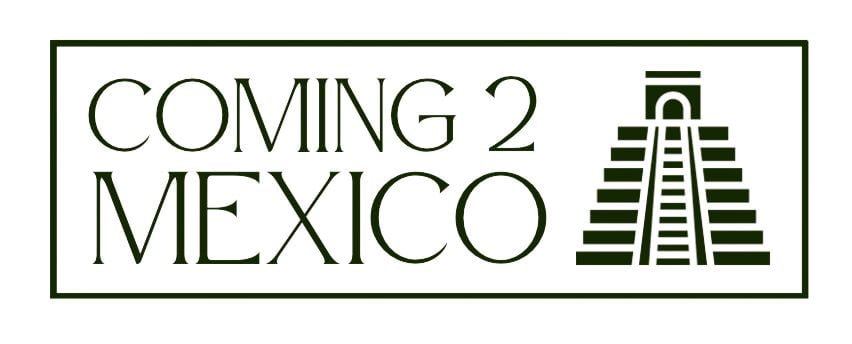Contents
- 41 Authentic and Thoughtful Souvenirs: The Ultimate Guide for Things to Get in Mexico
- Authentic Mexican Art and Handcrafts
- 1. Talavera Pottery (Puebla, Guanajuato)
- 2. Silver Jewelry (Taxco)
- 3. Barro Negro Pottery (Oaxaca)
- 4. Huichol Art (Nayarit, Jalisco)
- 5. Amber Jewelry (Chiapas)
- 6. Otomi Textiles (Hidalgo)
- 7. Handwoven Rugs (Oaxaca)
- 8. Alebrijes (Oaxaca)
- 9. Carved Gourds (Oaxaca)
- 10. Copper Products (Santa Clara del Cobre, Michoacán)
- 11. Amate Art (Puebla, Oaxaca, Guanajuato)
- Things to Get in Mexico for Foodies
- 12. Mexican Chocolate (Oaxaca, Chiapas, Tabasco)
- 13. Vanilla (Veracruz)
- 14. Mexican Candy (Anywhere)
- 15. Mexican Coffee (Chiapas, Veracruz)
- 16. Mexican Hot Sauce (Anywhere)
- 17. Mexican Spices (Various regions)
- 18. Melipona Honey (Yucatan)
- 19. Mole Poblano (Puebla)
- 20. Molcajete (Jalisco, Southern Mexico)
- 21. Mexican Wine & Spirits (Various regions)
- 22. Sal de Gusano – Worm Salt (Oaxaca)
- 23. Mexican Cookbooks (Various regions)
- Fun and Festive Things to Get in Mexico
- 24. Mexican Musical Instruments (Various regions)
- 25. Coconut Masks (Guerrero)
- 26. Day of the Dead Decorations (Various regions)
- 27. Papel Picado (Various regions)
- 28. Frida Kahlo Memorabilia (Mexico City)
- 29. La Catrina Figures (Michoacan)
- 30. Lucha Libre Masks (Mexico City)
- 31. Zapatista Dolls (Chiapas)
- 32. Gourd Lamps “Jellyfish Lamps” (Riviera Maya)
- Beautiful and Practical Gifts from Mexico
- 33. Huipiles (Chiapas, Yucatan)
- 34. Hammocks (Yucatan)
- 35. Rebozos (Michoacan)
- 36. Guayaberas (Yucatan)
- 37. Traditional Cooking Items (Various Regions)
- 38. Hand Painted Converse Sneakers from Pintando Pasos (Mexico City)
- 39. Hand-blown Glassware (Various regions)
- 40. Mexican Sports Memorabilia (Various regions)
- 41. Cowboy Boots (León, Guanajuato)
- Finding the Best Mexican Souvenir from Your Mexican Adventure
41 Authentic and Thoughtful Souvenirs: The Ultimate Guide for Things to Get in Mexico
Mexico welcomes visitors with a rich cultural heritage that dates back to ancient civilizations. The bustling local markets, vibrant colors, and the aroma of delicious food encapsulate the essence of Mexican culture. One of the best ways to relive the memories of your experiences in this diverse country is by bringing back souvenirs from the places you have traveled.
We think the best things to get in Mexico are the ones you find in the local market or from local artisans who are carrying on traditional designs and techniques of a craft specific to the region you are in. If you are in Oaxaca, look for Barro Negro pottery, colorful Alebrijes or a handwoven rug.

If you have a Chef or a foodie in your life, traditional kitchen tools, commonly used ingredients and authentic serving pieces are great things to bring home. A special bottle of mezcal, some sal de gusano and a set of jicara serving cups are another great idea. If you are visiting the Chichen Itza or anywhere in the Yucatan, look for authentic Guayabera shirts, handwoven hammocks and a fine bottle of Xtabentun to bring home.
Some of these items on my list are specific to a particular state or region. Most you can find for sale in popular tourist destinations all over Mexico. The list is diverse and I have tried to consider all kinds of travelers. I hope you find this list interesting and informative and helpful when trying to decide the best things to get in Mexico to remember your travels.
Authentic Mexican Art and Handcrafts
1. Talavera Pottery (Puebla, Guanajuato)
Talavera pottery is a blend of Mexican and Spanish artistic traditions, dating back to the 16th century when Spanish artisans brought the craft to Mexico. The process involves multiple stages of molding, firing, glazing, and hand-painting, often by artisan families who have passed the techniques down through generations. Authentic Talavera pottery is certified by the Mexican government to ensure it’s made according to traditional methods and standards.

If you are a collector or a ceramics buff, you can find plenty of Talavera talleres (workshops) that will help you package and ship your precious purchases back to your home country. Handpainted Talavera tiles are a great way to liven up your kitchen or bathroom. You can buy them all in the same design or buy a mix of designs to cover a counter, backsplash or even stair risers.
Handpainted tiles with numbers are beautiful house markers and make a colorful and thoughtful gift. The tiles can also be customized with any wording you like, such as your own name or address or “Mi Casa es Su Casa“. Talavera originated in Puebla but you can also find very nice pieces in Guanajuato and distributed around the country.
2. Silver Jewelry (Taxco)
Taxco, often dubbed the “Silver Capital of the World,” is nestled in the mountains of Guerrero, Mexico. Its rich veins of silver have been mined since the pre-Columbian era, but it was in the 1920s that Taxco’s silver legacy was rejuvenated by American architect and designer William Spratling. He recognized the potential of combining Taxco’s silver with traditional Mexican motifs, leading to a renaissance in silver craftsmanship.
Taxco silver is sought-after for its high quality and intricate designs. The town’s skilled artisans, trained over generations, craft pieces that range from contemporary elegance to traditional indigenous motifs, often including semi-precious stones in the design.
Some notable silver artists include Antonio Pineda and Hector Aguilar. For authentic pieces, visit Taxco’s bustling weekly silver market, Tianguis de Plata, or its numerous reputable shops. The city is dotted with boutiques, each offering unique designs, ensuring that every visitor finds a piece that resonates.
To ensure you’re purchasing genuine Taxco sterling silver, look for the “.925” stamp, indicating 92.5% pure silver content. Genuine Taxco silver jewelry often carries a hallmark of the artist or workshop, a testament to its authenticity and craftsmanship.
3. Barro Negro Pottery (Oaxaca)
Barro Negro (Black Clay) pottery has its roots in the ancient civilizations of Mexico. The unique black color and intricate designs are a part of a centuries-old tradition, originating in the Oaxaca region. The creation of Barro Negro pottery is a labor-intensive process carried out by experienced artisans. The elegant, black color of Barro Negro is achieved through a special firing process.

If you are traveling through Oaxaca, traditional workshops like the Alfarería Doña Rosa or other family-run shops in San Bartolo Coyotepec are great places to see the crafting process and purchase authentic Barro Negro. You can also find it in local markets all over the region and in fine art shops across the country. We have made many trips to Oaxaca and I have brought back many pieces of Barro Negro but my favorite pieces are a simple dove and her baby that remind me of the house I stayed in the first time I visited Oaxaca with my kids, “Casa Paloma”.
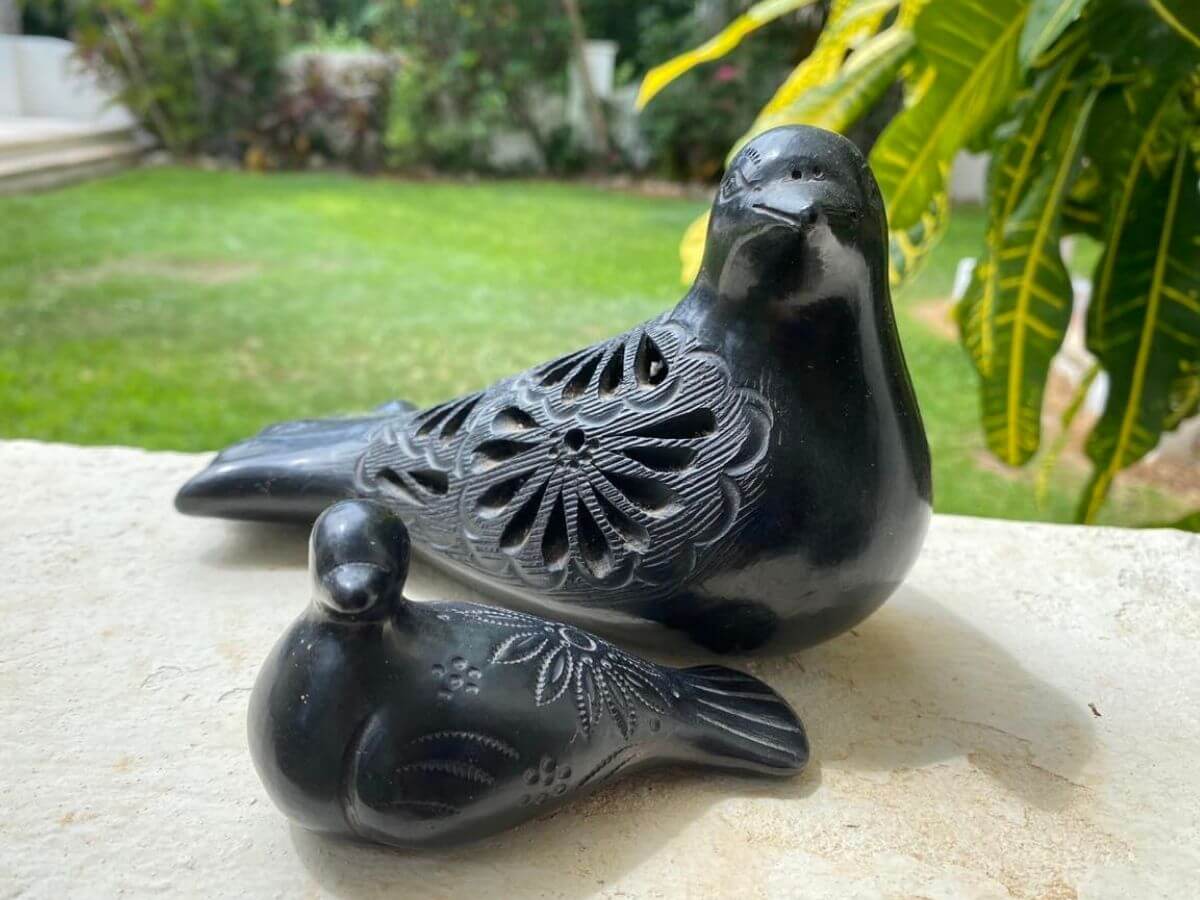
4. Huichol Art (Nayarit, Jalisco)
The Huichol are a group of people primarily from Nayarit, the Mexican state just to the north and east of Puerto Vallarta. Beadwork and yarn paintings are the two most notable forms of Huichol art. Yarn paintings are inspired by the dreams that visit the curanderos during a peyote ritual and often contain many of the sacred symbols of the Huichol people including deer, peyote, suns and moons and fire.
You can find authentic Huichol art in the states of Nayarit and Jalisco, the traditional homelands of the Huichol people. Huichol art can also be found in galleries and museum shops in Mexico City and other metropolitan areas. Pieces range in size and cost but you can bring home a small, hand-beaded figure for under 500 pesos. On one of my first visits to Guadalajara, I bought a large, intricately decorated Huichol yarn painting that still hangs in my home.
5. Amber Jewelry (Chiapas)
Chiapas is renowned for its exquisite amber, often polished and shaped to be crafted into beautiful jewelry. This region’s amber is considered among the finest in the world due to its clarity and the variety of colors it comes in, ranging from the common golden-honey hues to rare shades like red, green, and blue.
You can find amber jewelry all over Chiapas, especially in San Cristobal de las Casas. Be sure to verify that the amber is authentic as there are vendors passing off cheap imitation pieces to suspecting tourists looking for a good deal. I found a stunning pair of earrings in the shop of the Amber Museum which they were happy to verify so I would be reassured that I was getting the real deal.
6. Otomi Textiles (Hidalgo)
Otomi textiles represent a great Mexican tradition that has been passed from generation to generation. Originating in Tenango de Doria, Hidalgo, and often referred to as Tenango textiles, each piece is hand embroidered on ivory muslin by artisans. The Otomi designs are based on the native flora and fauna of the Otomi region and are most often represented in embroidered textiles such as table runners, pillow shams, blouses, dresses, belts and other decorative items.

You can also find items handpainted with Otomi designs. I have a series of four pieces of Otomi embroidery framed in my home and I love them! When I no longer have dogs and children to consider, my first empty-nest gift to myself will be a set of Otomi accent pillows for my living room.
7. Handwoven Rugs (Oaxaca)
The Zapotec people, native to the Oaxaca region, have been weaving textiles for over 2,000 years. Authentic Oaxacan rugs are made from locally sourced wool which is laboriously cleaned, carded, spun into yarn, and then dyed using natural dyes derived from plants, insects, and minerals. The use of natural dyes is a hallmark of traditional Oaxacan rug weaving. Dyes are created from materials like the cochineal insect (red), purpua snail shells (purple), wild indigo plants (blue) and marigold flowers (yellow).
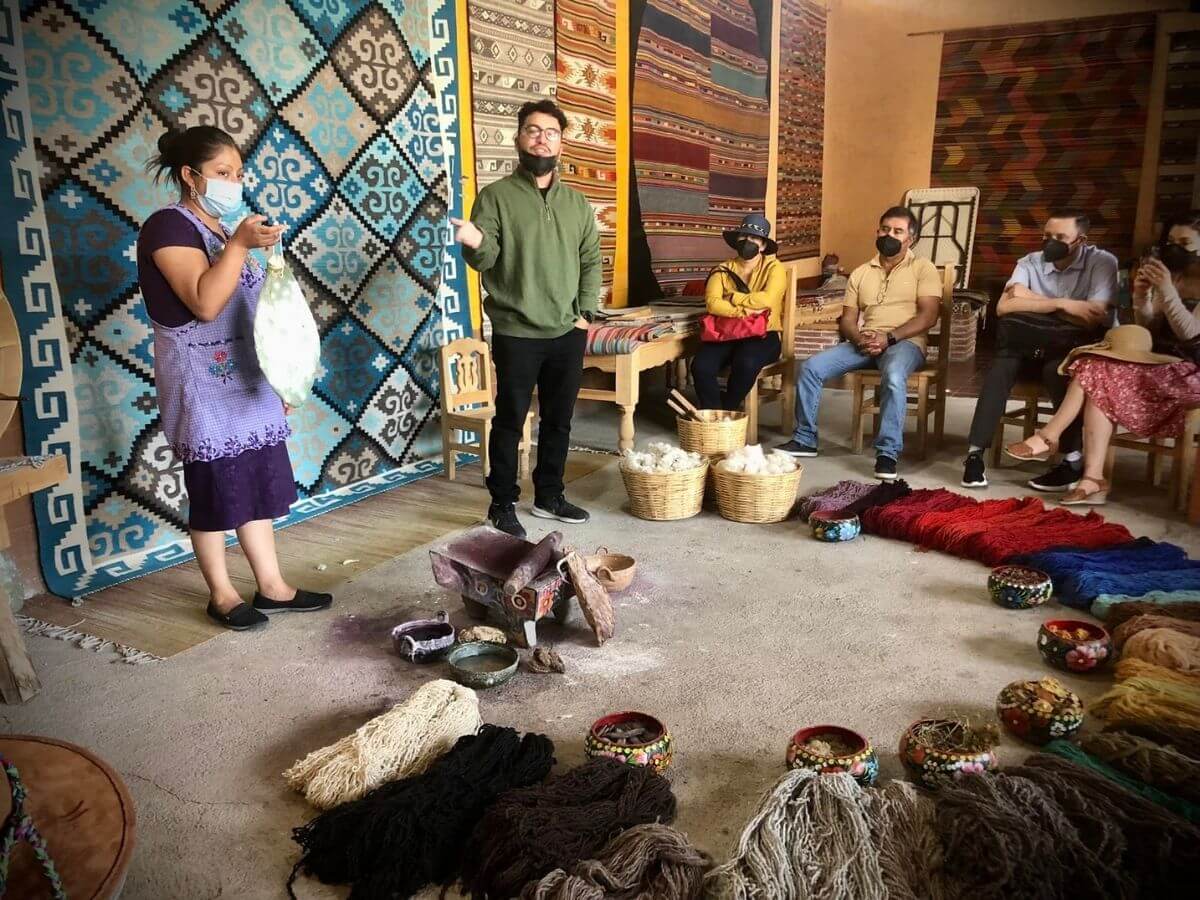
The rugs are woven on hand looms, a process that requires skill, strength, and a lot of patience. The looms are often simple wooden frames, and the weaving process can take several days to several weeks, depending on the complexity of the design. Buying directly from artisans in their workshops is a wonderful way to learn about the process and ensure the authenticity and quality of your rug. To see the rugs being made and find authentic rugs at the best prices, take a trip to the tiny village of Teotitlán del Valle where families have been weaving rugs for generations.
8. Alebrijes (Oaxaca)
The tradition of crafting alebrijes began in Mexico City in the 1930s by an artist named Pedro Linares. During an illness, he dreamt of bizarre, fantastical creatures, which he then began to craft from papier-mâché upon recovery. The tradition has since spread and evolved, becoming a cherished form of Mexican folk art. Today, Oaxaca is the heartland of alebrije craftsmanship. Towns like San Antonio Arrazola and San Martín Tilcajete are renowned for their alebrijes crafted from the soft wood of the copal tree.
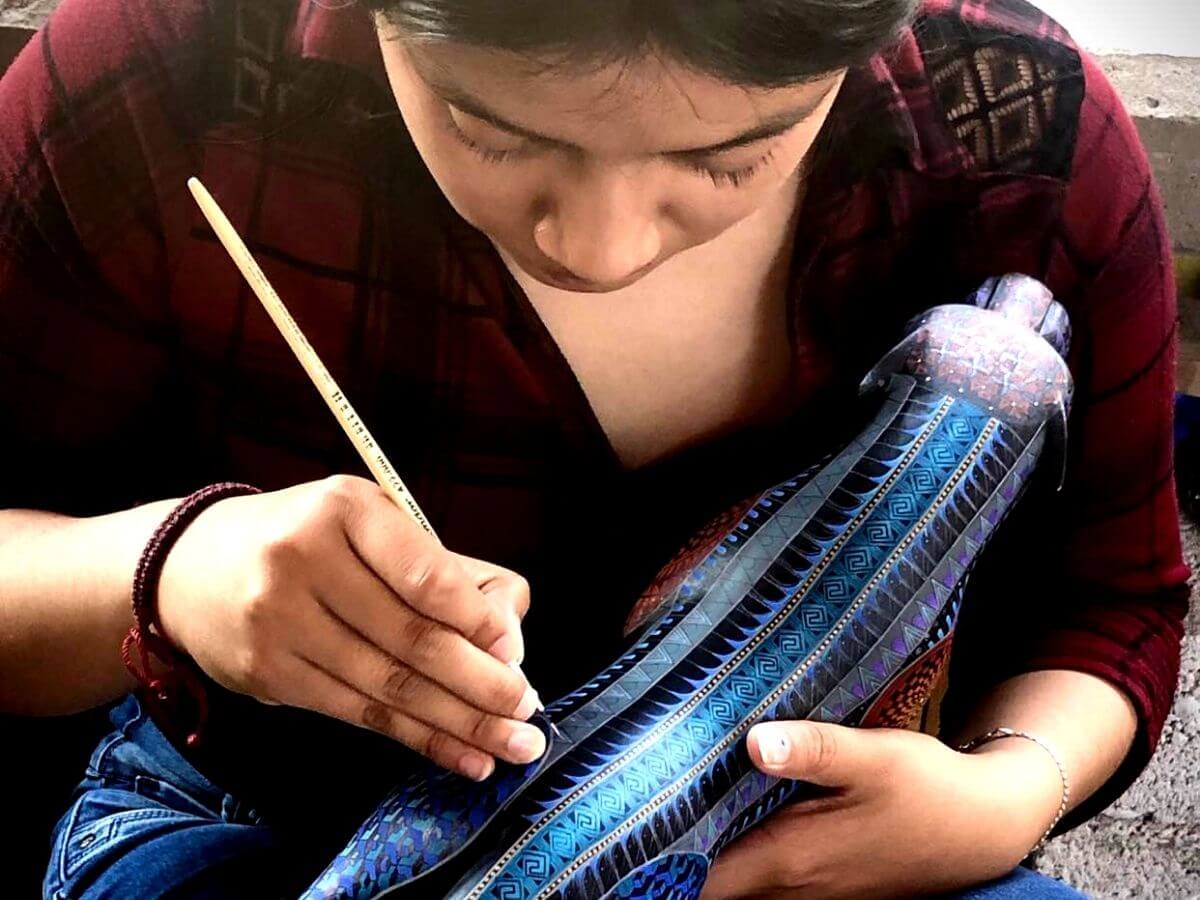
If you are a Mexican folk art collector, galleries, cultural centers and museums in tourist areas often carry high-quality alebrijes. Look for vendors who provide information about the origin and craftsmanship of the pieces they sell. Expect to pay good money for the best pieces from renowned artisans. You can also pick up small, animal figures from 30 pesos and up that make great gifts for kids.
9. Carved Gourds (Oaxaca)
There is historical evidence showing that people have been drying gourds to use as containers, utensils, serving vessels and decorative items dating back to pre-Hispanic times in Mexico. The gourds were often carved or painted with symbolic imagery from Mexican folklore, religion or depictions of scenes from daily life. Today, Oaxaca is known for its gourd artistry.
The carved and painted gourds (Jicaras Grabadas) from this region often feature intricate designs and bright colors, showcasing the skilled craftsmanship of Oaxacan artisans. Today, you can find gourds used to make cups, bowls, lamps and even Christmas tree ornaments. If you are planning to bring back a bottle of Mezcal from your trip to Mexico, a set of traditional jicara serving cups would make a fantastic accompaniment to that gift.
10. Copper Products (Santa Clara del Cobre, Michoacán)
The ancient Purepécha people native to the area known today as Santa Clara del Cobre, were widely known as excellent coppersmiths even before the Spanish conquest of Mexico. The Spanish conquistadores brought new techniques for working the copper from Europe which complimented the Purepécha´s special method of extracting the metal from the ore by adding heat.
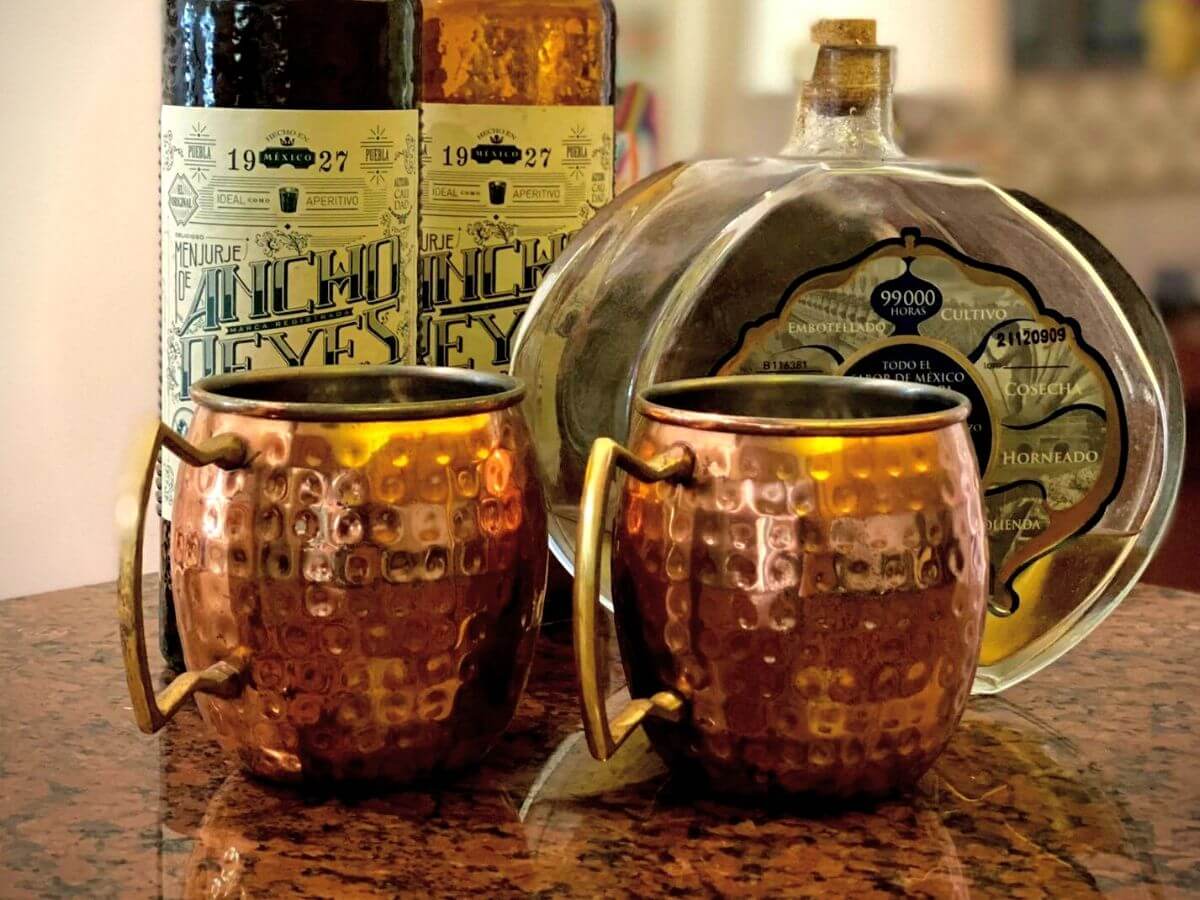
Today, new generations of coppersmiths in Michoacan continue to create durable 100% copper pieces used and cherished in many Mexican households. Copper comales, cazos (pots), sinks, jarras and even fine jewelry can be found in the mercados and shops specilizing in the very best copperware. Authentically made copper products from Santa Clara are highly sought-after and make a beautiful and useful gift from Mexico.
11. Amate Art (Puebla, Oaxaca, Guanajuato)
Amate paper art has its roots in the pre-Hispanic era of Mexico. Indigenous peoples, including the Maya and Aztec civilizations, created this traditional bark paper for over a thousand years. The process of making Amate paper is labor-intensive. It begins with harvesting the bark from fig or mulberry trees. The bark is boiled and laid out on wooden boards. Artisans beat the fibers until the pulp spreads out to form sheets of paper which are then left to dry in the sun.
The paper can then be shaped into three-dimensional patterns or painted with village scenes or depictions of spirit animals that have been passed down from generation to generation.
Things to Get in Mexico for Foodies
12. Mexican Chocolate (Oaxaca, Chiapas, Tabasco)
Chocolate has its roots in ancient Mesoamerica, dating back to the Olmec civilization around 1500 BC. However, it was the Maya and later the Aztecs who truly cultivated and revered cacao. There are historical records, including codices from the pre-Columbian era, that depict cacao beans being used as currency. It even served as a standard of value in trade, with other goods given value in terms of cacao beans.
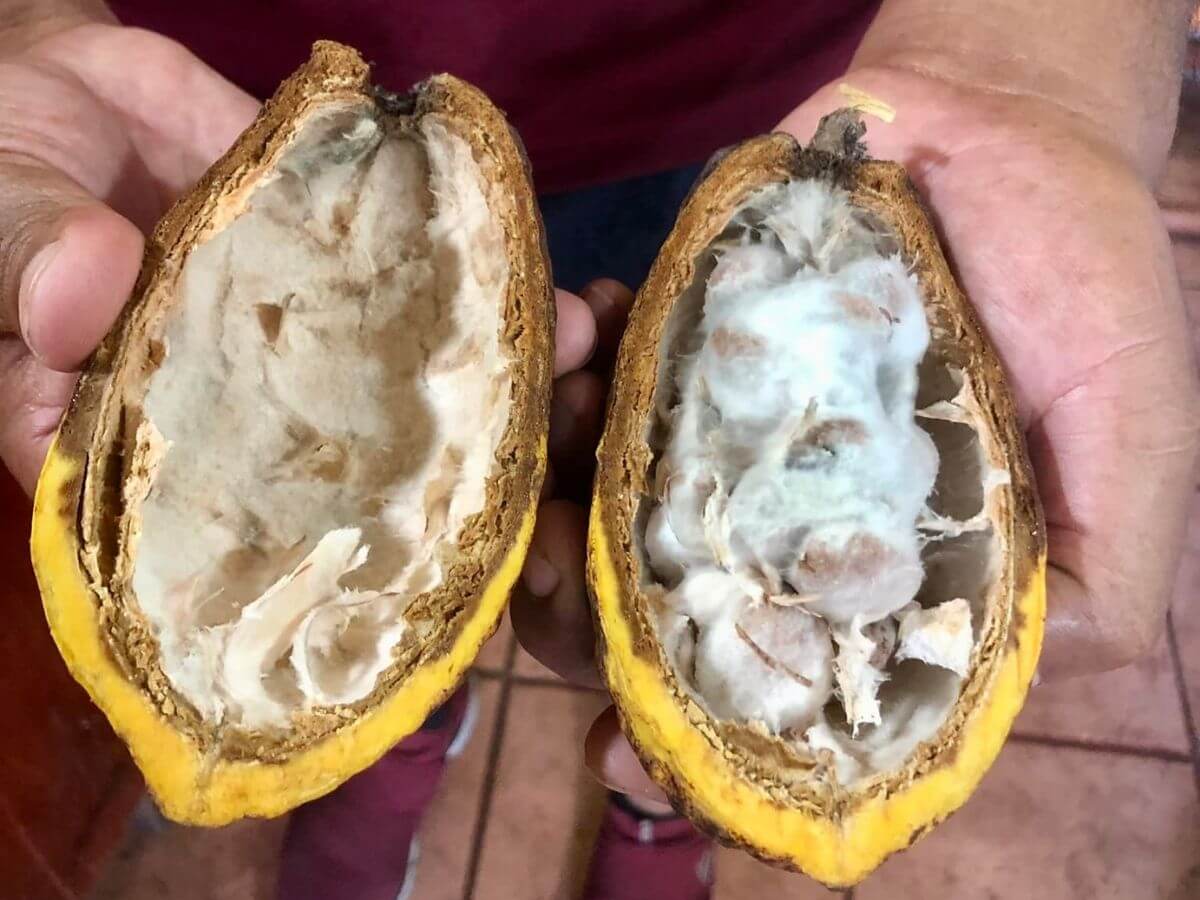
Today, known as the land of chocolate, Oaxaca is the place to find traditional Mexican chocolate. The city is home to numerous homes and workshops where you can learn about the chocolate-making process and buy their handmade artisanal chocolate. The states of Chiapas and Tabasco have the lion´s share of Mexico´s cacao plantations. If you are able to arrange a visit to one of these farms, you are sure to find them making wonderful chocolate which you can buy right from the producer.
13. Vanilla (Veracruz)
The Totonac people of Veracruz, Mexico are credited with being the first to propagate and use vanilla. Authentic Mexican vanilla is produced from natural vanilla orchids. The process of pollination is often done by hand, and the curing process of the beans is labor-intensive, contributing to the high quality of the final product.
Mexican vanilla is known for its unique, rich flavor and sweet, creamy aroma with a hint of spice. Its complex flavor profile is often considered smoother and more nuanced compared to other varieties. If you are in the region where it is commonly cultivated, you may be able to find a tour guide to show you how it is grown, harvested and processed. This would be the ideal opportunity to purchase some to bring back but you can also find it in local markets and specialty shops. Just be sure to check the label to verify that it is 100% pure vanilla.
14. Mexican Candy (Anywhere)
If you have someone with a sweet tooth back at home, Mexican candies make a fun and unique gift to bring. Among the most traditional are Mazapanes, sweet, soft candies made from ground peanuts and sugar and Alegrias, made from amaranth seeds and honey or molasses. Other popular varieties include candies made from the pulp of the tamarind fruit, mixed with sugar, and often spiced with chili.
Also, look for Glorias which are chewy caramel candies often filled with nuts like pecans. Chamoy candies are also uniquely Mexican. They have a sweet, spicy, and sour taste, made with apricot, plum, or mango as the base and spiced with chili. My kids love these. My favorites are Obleas, thin, wafer-like candies often filled with sweet caramelized goat milk known as cajeta. You can find Mexican candy in any market or grocery store or take a special trip to the “Calle de los Dulces” in Puebla.
15. Mexican Coffee (Chiapas, Veracruz)
Much of the coffee in Mexico is grown by small family farmers in Chiapas and Veracruz who adhere to traditional and organic farming practices. These methods not only contribute to the quality of the coffee but also to sustainable agriculture in the region. While you are visiting Chiapas or Veracruz, coffee farm tours offer an immersive experience. You can see how the coffee plants are cultivated, learn about the production process and sample and purchase coffee directly from the source.
Authentic Mexican coffee can also be purchased from local markets, coffee cooperatives, or reputable cafes throughout the state. Chiapas and Veracruz are home to several Fair Trade cooperatives that ensure farmers receive a fair price for their coffee. It’s a way to bring home a taste of Mexico.
16. Mexican Hot Sauce (Anywhere)
Mexican cuisine boasts an incredible variety of hot sauces, each with its unique flavor profile derived from specific chiles and preparation methods. When traveling in Mexico, exploring the local salsas is a culinary adventure in itself. If you or your loved ones are foodies (like we are) a selection of Mexican salsas and hot sauces is one of the best souvenirs you can bring home.
Some of the varieties to look for are tangy salsa verde which features tomatillos and fresh green chiles like serano or jalapeño, smokey salsa taquero tomatoes, garlic and white onion blended with dried chiles de arbol or guajillo, salsa ranchero featuring tomatoes with dried guajillo or pasilla chiles, salsa de chile morita, salsa macha an oil-based sauce with fried ancho or morita chiles, garlic, and sometimes nuts or seeds, salsa de cacahuate which has roasted peanuts blended with chiles de arbol or guajillo and spicy salsa de habañero, made from fresh green or red habañero peppers.
Local markets are the best place to find authentic and fresh hot sauces. Each region will have its specialties. Supermarkets also offer popular brands in Mexico that are most commonly used. You can find all of these in small bottles that are easy to take home from your Mexico vacation.
17. Mexican Spices (Various regions)
Mexico is certainly the land of chiles. Walk into any market and you will find a dizzying array of brightly colored peppers and dried chiles. Look here for an assortment of pasillo, ancho, guajillo, and chipotle chiles to bring home. Achiote, used to marinate the pork for Mexico´s famous Tacos al Pastor can be easily found well-packaged in paste form.
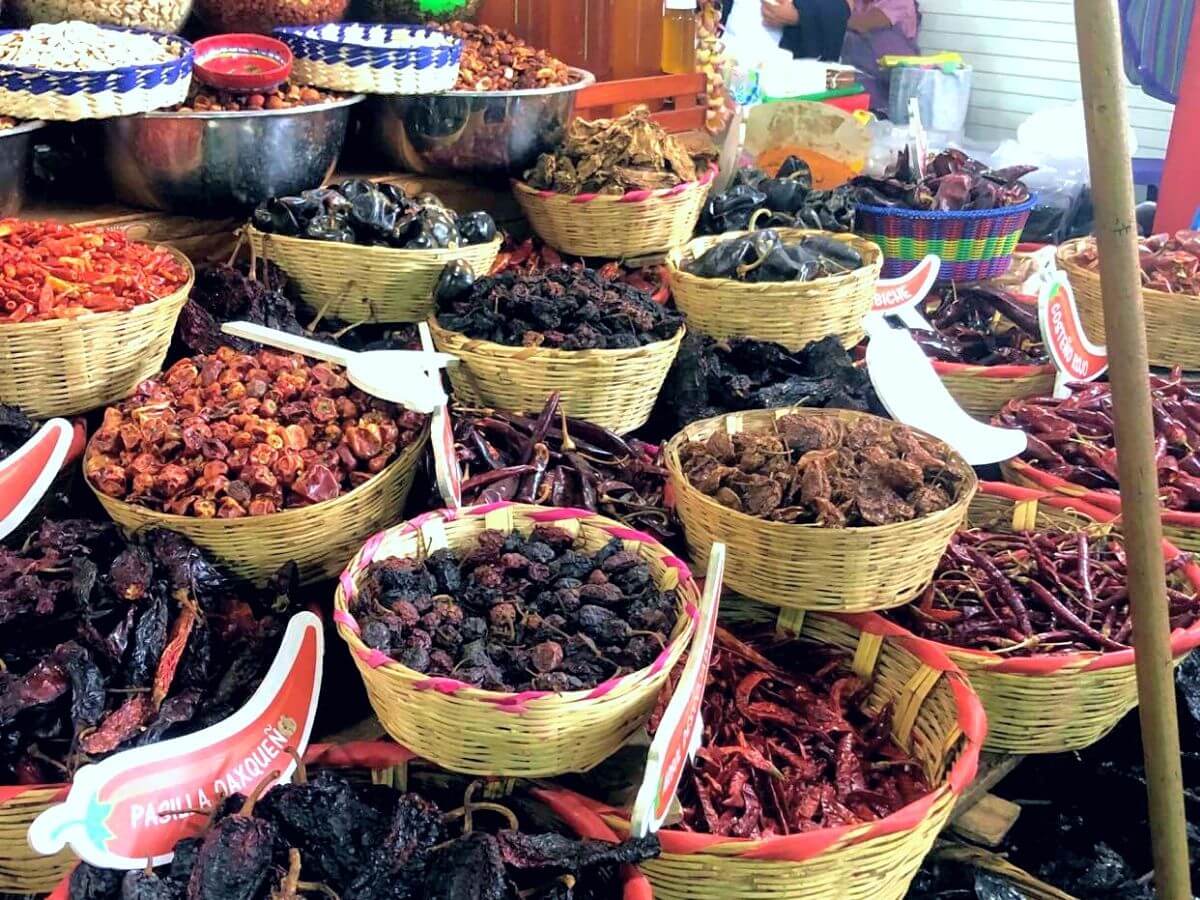
“Tajin”, a chile-based spice blend, is ubiquitous to Mexico. People use it to rim cocktail glasses and sprinkle it on fruits, vegetables and all manner of things. You can also look for spices such as Mexican oregano, epazote and avocado leaf, all used in traditional dishes in authentic Mexican cuisine. Check the local markets to see what else you might find!
18. Melipona Honey (Yucatan)
Melipona Honey is produced by the stingless Melipona bee, native to Mexico, particularly the Yucatan Peninsula. This type of honey is rare and has been cherished by the Mayans for thousands of years for its medicinal properties. It’s believed to have antibacterial, anti-inflammatory, and healing properties, making it a natural remedy for various ailments.
The tradition of Melipona beekeeping is a part of the Mayan cultural heritage. There are even some eco-friendly resorts in the Yucatan Peninsula have their own Melipona beekeeping projects and sell honey on-site. You can find Melipona honey in the markets of the Yucatan, especially in Merida and Valladolid. If you find yourself on the Riviera Maya, let me know through our CONTACT US form and I will put you in touch with my personal source.
19. Mole Poblano (Puebla)
Mole Poblano has deep historical roots dating back to the colonial era. It’s believed to have been created by nuns at the Convent of Santa Rosa in Puebla. The dish is a beautiful blend of indigenous and Spanish culinary traditions. It is considered a “special occasion” dish with a unique blend of ingredients, which can include chili peppers, chocolate, almonds, tomatoes, raisins, and a variety of spices. This results in a rich, multi-layered flavor profile that is sweet, spicy, and savory.
You can find Mole Poblano packaged for sale, concentrated in a paste in the local markets of Puebla (and across Mexico) and sometimes in the restaurants where it is served. If you have room in a checked bag, this is a special treat for the foodies in your life.
20. Molcajete (Jalisco, Southern Mexico)
A molcajete is a quintessential item in any traditional Mexican kitchen and has been used for thousands of years, dating back to ancient Mesoamerican cultures. Even today, a molcajete is commonly used to make Mexican salsa and Mole sauce among other things. Using a molcajete enhances the flavors of the ingredients by grinding and blending them together slowly. It offers a unique, hands-on culinary experience that modern kitchen gadgets can’t replicate.
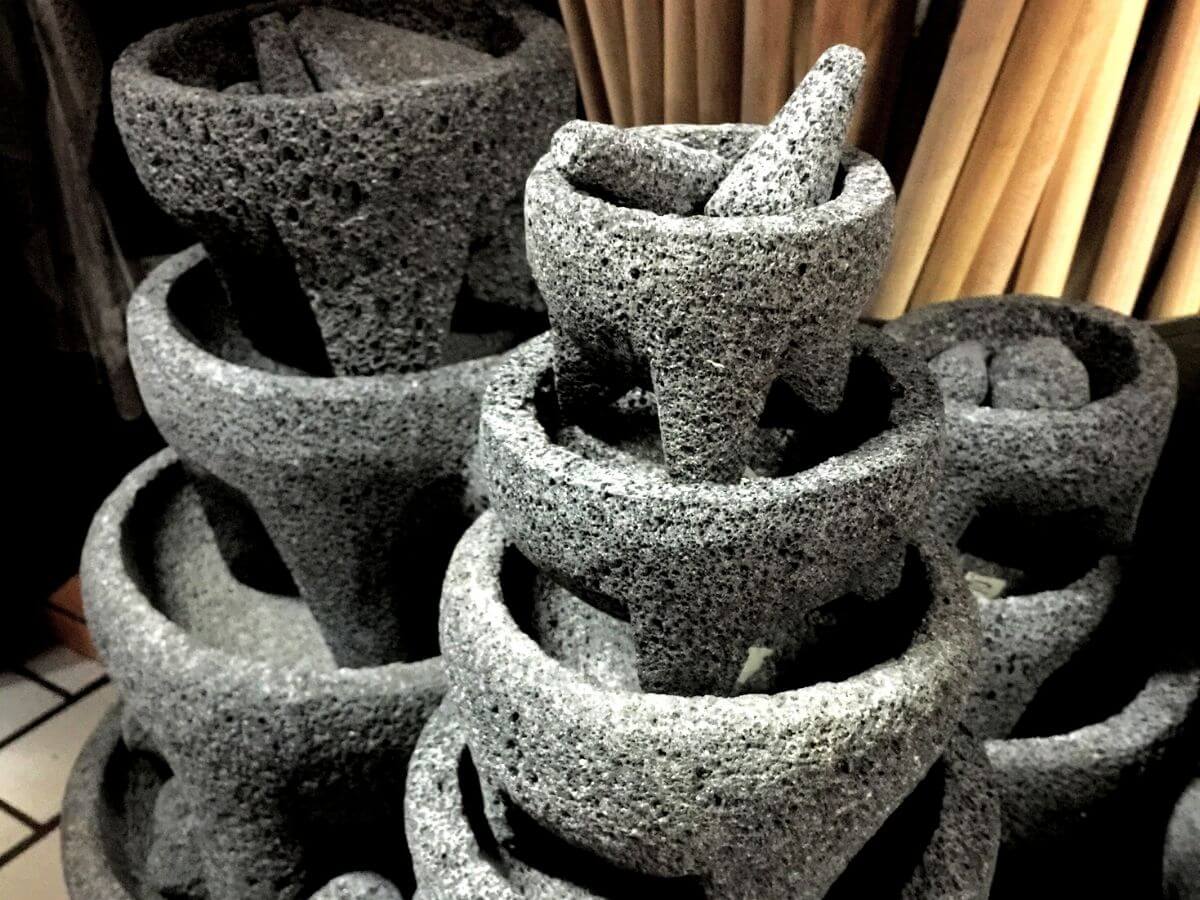
Molcajetes are made from volcanic stone, making them incredibly durable. A molcajete is probably one of the more unusual things to get in Mexico as they are very heavy and difficult to travel home with meaning you have to plan ahead. However, with proper care, a molcajete can last a lifetime, making it a timeless souvenir for you or the serious foodie in your life.
21. Mexican Wine & Spirits (Various regions)
Tequila is without a doubt one of the most popular things to get in Mexico. Because the name “Tequila” has the coveted Denomination of Origin (DO), it may only be produced in certain designated regions and must be made from at least 51% Blue Agave. The state of Jalisco is the “heartland” of tequila and where most of the producers are located.
But, Mexico’s spirits do not stop at Tequila! If you traveling around the Yucatán peninsula, look for Xtabentun, a curious licorice-flavored liqueur that originated in this region. Mezcal, tequila´s cousin, has become very popular over the last decade both here in Mexico and around the world. A nice bottle of small-batch Mezcal from Oaxaca makes a unique gift. One of my favorite Mexican spirits is a chile based liqueur from the state of Puebla called Ancho Reyes. This unusual spirit is often used in Mezcal cocktails but is also delicious chilled and sipped straight.

Also, not to be overlooked are Mexico´s amazing wines. Wine popularity and production in Mexico is skyrocketing with people calling Valle de Guadalupe the “Napa of Mexico”. If you are a wine lover, you can now find wine shops all over Mexico with knowledgeable sommeliers who can help you bring back some really find bottles for your oenophile back home. *** Do be aware of your country’s regulations on alcohol importation and your airline’s restriction on traveling with liquids to avoid any issues at check-in or customs.
22. Sal de Gusano – Worm Salt (Oaxaca)
Indigenous people of Mexico have been utilizing agave worms, or maguey worms, in their cuisine for centuries. Today, due to the skyrocketing popularity of Mezcal, the maguey worm is in danger of extinction so other types of larvae are now used to create this savory condiment. To achieve its characteristic flavor, chiles and sea salt are added and the ingredients are then dried and ground into a powder.
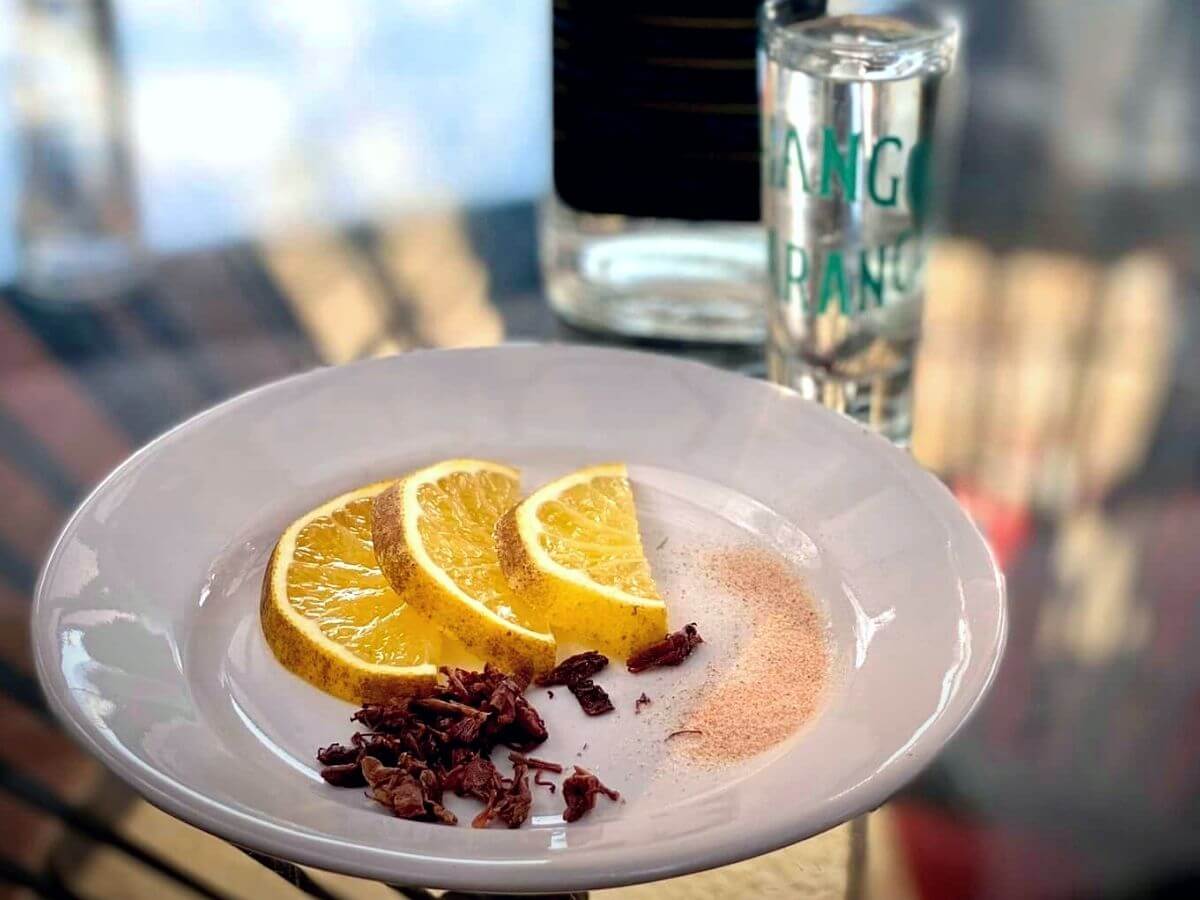
Today, Sal de Gusano is commonly served to accompany Mezcal. It can be sprinkled on orange slices or used to rim a glass. You can also find Sal de Chapulin (grasshopper salt) and the whole, dried insects which are also a traditional accompaniment to serve with Mezcal. Sal de gusano can be easily found in markets in Oaxaca, Mexico City and anywhere Mezcal is produced. Sal de gusano is an inexpensive and truly unique gift from Mexico to bring back for the foodie in your life.
23. Mexican Cookbooks (Various regions)
Mexican cookbooks make a great gift for your Mexican food lovers back home. These are some fantastic cookbooks written by renowned Mexican chefs that are available in English. “Mexico: The Cookbook” by Margarita Carrillo Arronte: This comprehensive tome offers over 700 traditional recipes from across the country. Margarita Carrillo Arronte, a renowned chef and culinary ambassador, provides a deep dive into the vast world of Mexican cuisine.
“My Mexico: A Culinary Odyssey with Recipes” by Diana Kennedy: Often referred to as the “Julia Child of Mexican cuisine,” Diana Kennedy has spent decades researching and documenting traditional Mexican recipes. This book is a culmination of her travels and culinary discoveries. “Tu Casa Mi Casa: Mexican Recipes for the Home Cook” by Enrique Olvera: Chef Enrique Olvera, of Pujol in Mexico City (one of the world’s top restaurants), offers recipes that showcase the essence of Mexican home cooking, blending traditional methods with modern twists.
Fun and Festive Things to Get in Mexico
24. Mexican Musical Instruments (Various regions)
If you have a musician or music collector at home, a musical instrument native to or commonly used in Mexico makes a very thoughfuñ gift. While most Mexican musical instruments are too big to bring home, (try fitting a Jarocha Harp in the overhead bin) there are a few that, if you can find them, will make the perfect gift for the musician in your life. An Ocarina is an egg-shaped globular flute usually made of clay or metal. The dances, songs and rituals of the Aztec and Mayan peoples were commonly accompanied by the ocarina.
Ayoyotes are another part of the musical legacy left by the Aztecs. Ayoyotes are percussion instruments, which are made from the hard shells of the seeds of the ayoyote tree. The dried seeds are tied to cloth or pieces of skin or attached to sticks. When shaken they make a sound similar to falling rain. Of course, one of the most ubiquitous musical instruments associated with Mexico is the Maraca. Maracas are hand-held percussion instruments originally constructed from gourds or turtle shells and filled with beans, beads, or pebbles to produce sound. Modern maracas are made of wood, plastic, and other materials such as rawhide. Maracas make festive Mexican gifts for kids and adults.
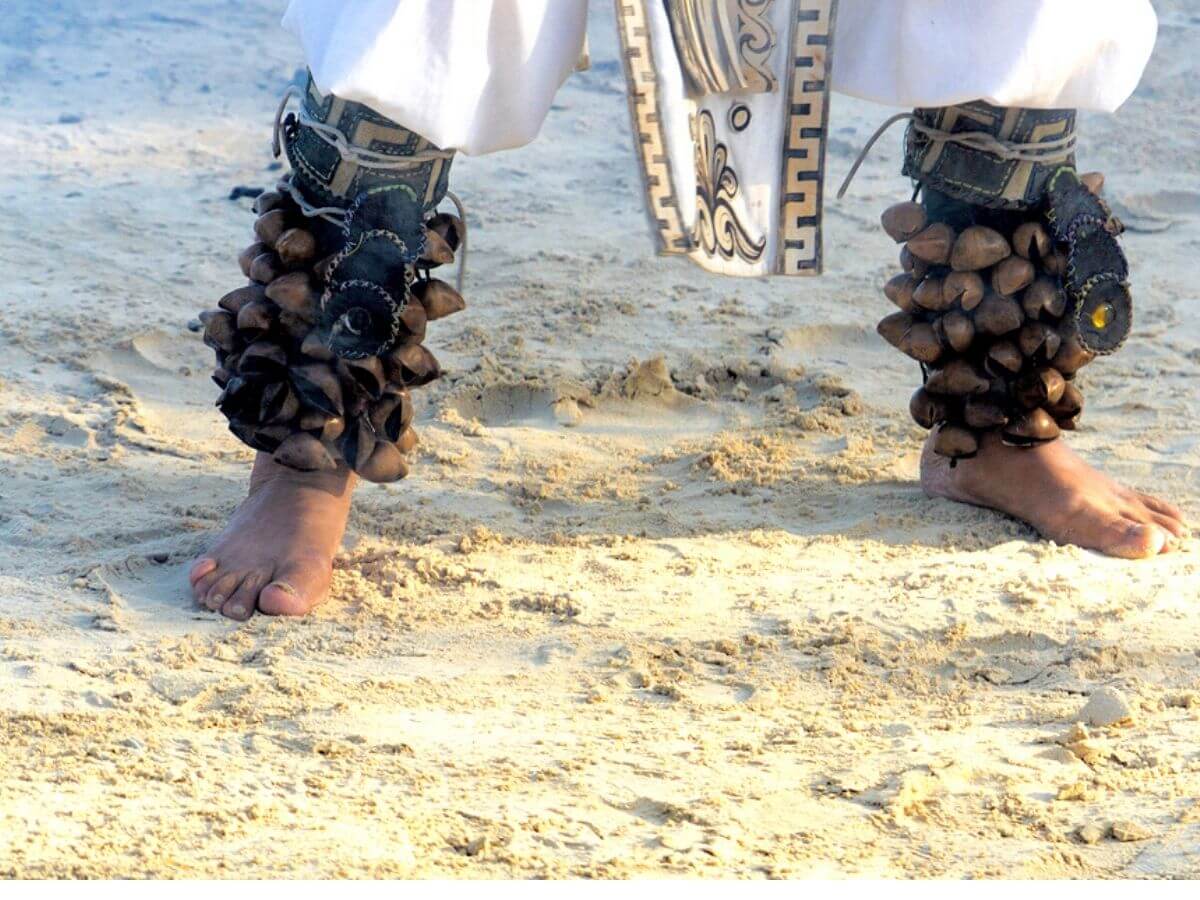
25. Coconut Masks (Guerrero)
Coconut masks are crafted from the shells of coconuts, utilizing a natural material in a creative and innovative way. Some of the best are made by Nahuatl artists who live in the Mezcala region along the Balsas River Basin in the state of Guerrero. These masks are often adorned with other organic materials like clay, pods, seeds and rope before being beautifully painted.
They can depict anything from the sun and moon to human faces to animals. Mythical creatures like devils, dragons and mermaids are also very popular. Coconut shell masks are widely distributed in artisan shops in all the popular tourist locations. They are relatively inexpensive and lightweight making them one of the best things to get in Mexico.
26. Day of the Dead Decorations (Various regions)
The Day of the Dead, or “Día de los Muertos,” is one of Mexico’s most iconic and vibrant celebrations. It’s a time to honor and remember loved ones who have passed away. The holiday is rich in symbolism, and many of its traditional items make unique and meaningful souvenirs. Some of the most sought-after items that you can bring home from your trip to Mexico are handpainted calaveras (skulls), catrina figurines, papel picado, flowered headbands, traditional incense burners and copal, and sugar skulls.

You can even find tiny shadow boxes called nichos with Day of the Dead themes. Most of these items are easy to find, especially around the holiday which falls on November 1st and 2nd. You can bring them back from your trip and make your own Day of the Dead altar at home!
27. Papel Picado (Various regions)
Papel picado, which translates to “perforated paper,” is a traditional Mexican craft that showcases intricate designs cut into colorful sheets of tissue paper. This delicate art form has its roots in pre-Hispanic Mexico when indigenous people made a rough paper called “amate”, made from tree bark, for various rituals and celebrations. Originally the designs, often depicting birds, flowers, skeletons, and other motifs, were cut carefully by hand making every piece unique.
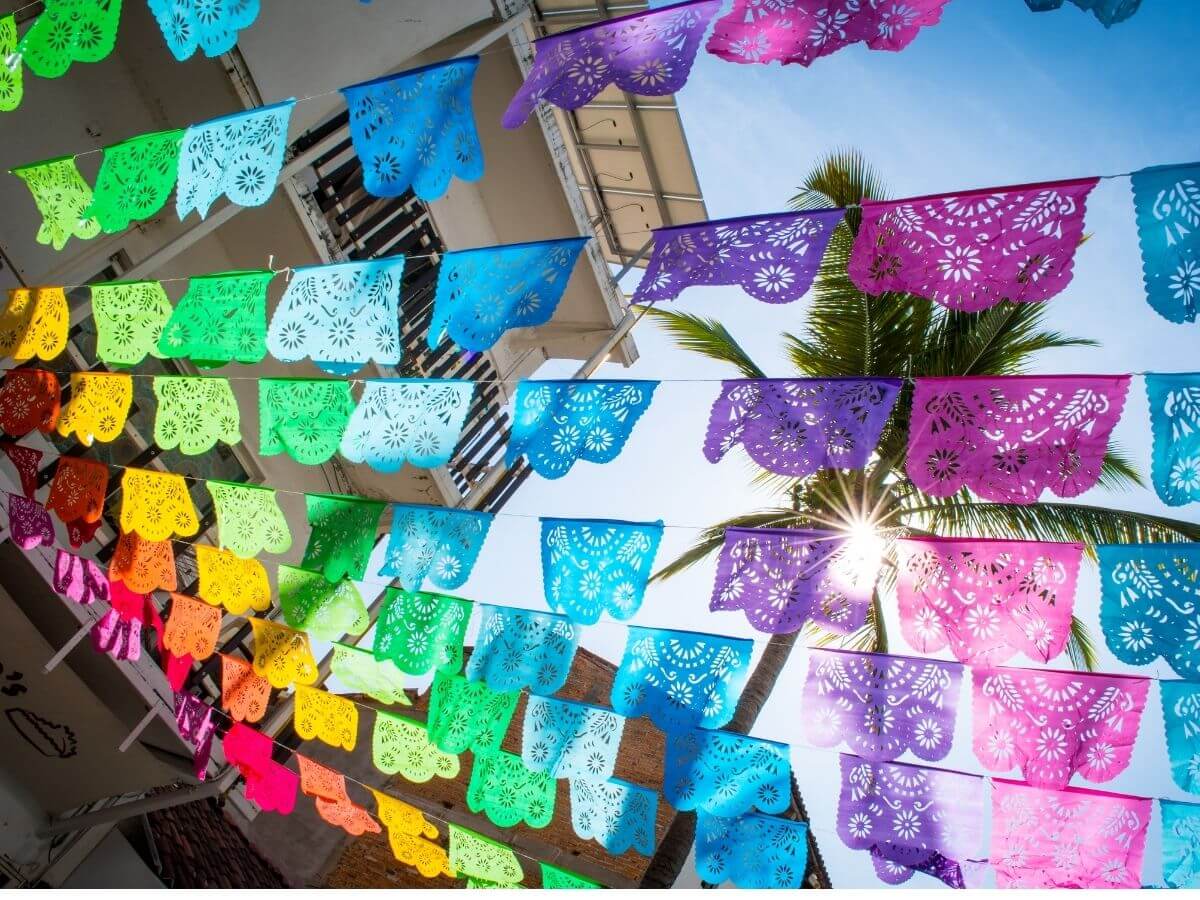
Today, due to demand and improvements in mechanization, commercially made papel picado can be found in most papelerias and even in grocery stores in Mexico. These mass-produced, laser cut, paper and plastic flags are commonly used in many celebrations such as the Day of the Dead, Christmas, weddings, baptisms, and quinceaneras among others. You can even order papel picado custom-made with the name of your family, business or the saying of your choice. Handcut papel picado is suitable for framing while the commercial-grade banners are great to string up to add a pop of Mexican flair to any room or party. Packs of papel picado are light and easy to pack and make great souvenirs.
28. Frida Kahlo Memorabilia (Mexico City)
Frida Kahlo was a Mexican painter known for her self-portraits and works inspired by Mexico’s nature, artifacts, and popular culture. Her art was deeply personal, often reflecting her struggles with physical health, her turbulent relationship with the famous Mexican muralist, Diego Rivera, and her strong political beliefs. Kahlo passed away in 1954 at the age of 47. Today, she is celebrated not only for her unique, highly personal style of painting but also for her involvement in political and feminist movements. She’s become an icon of resilience, individuality, and Mexican culture.
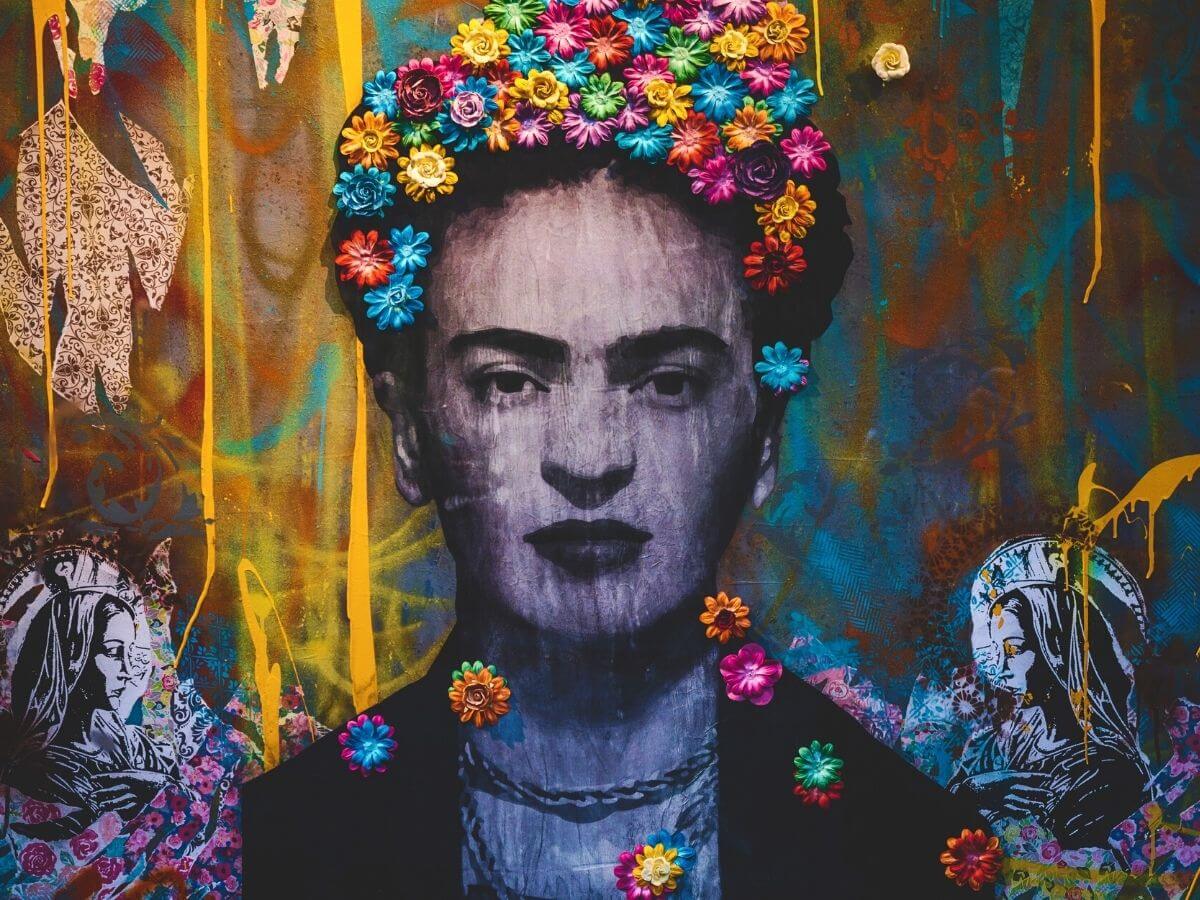
La Casa Azul, Frida Kahlo´s home, is located in Coyocan in Mexico City. This fantastic property has been turned into a museum dedicated to her life and work. The onsite gift shop offers a variety of Frida-themed souvenirs and is a great place to find some of the best Frida Kahlo memorabilia including prints of her most celebrated artwork. The popularity of this iconic figure has of spread across the country meaning that you can find Frida in markets and souvenir shops all over Mexico.
29. La Catrina Figures (Michoacan)
La Catrina originated in the early 20th century by Mexican artist José Guadalupe Posada. Initially, it was a satirical portrayal mocking the Euro-centric Mexican elite who were aspiring to adopt European aristocratic traditions. Over time, La Catrina became associated with Día de los Muertos (Day of the Dead), a Mexican holiday that celebrates and honors the deceased. The figure, depicted in various forms of art, from sculptures to paintings, symbolizes the cycle of life and death, reminding everyone of their mortality in a whimsical manner.

La Catrina figures can range from small, handheld figures to life-sized statues, each with its unique charm and level of detail. The more colorful and intricate the design, the more desirable the Catrina. The state of Michoacán, particularly the town of Capula, is known for its elaborate, ceramic Catrina figurines. You can also find top-quality Catrinas in Guanajuato and Mexico City.
30. Lucha Libre Masks (Mexico City)
Although not popularized until the 20th century, Lucha Libre masks are influenced by Mexico’s pre-Hispanic past, where masks were worn during battles and ceremonies. In Lucha Libre, the mask conceals the wrestler’s identity, creating a sense of mystique and a persona that becomes a part of the allure. The mask symbolizes the struggle between good and evil, a theme often portrayed in Lucha Libre matches. It´s fun to try and find the masks of the more famous wrestlers like Blue Demon, El Santo and Rey Misterio.
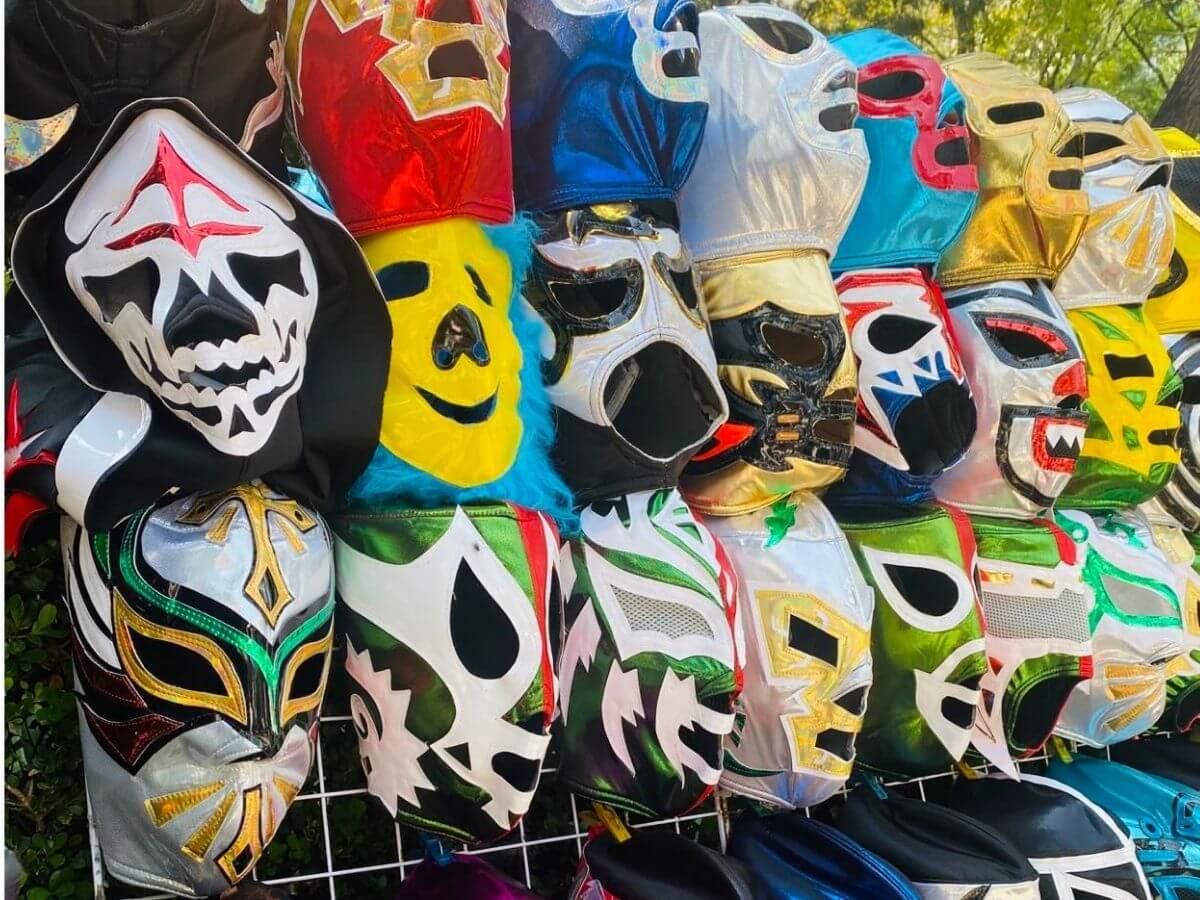
The best place to find an authentic Lucha Libre mask is in Mexico City, particularly around the Arena Mexico and Arena Coliseo, where Lucha Libre events are held. You can usually find Lucha Libre masks for sale from souvenir shops and street vendors in all the popular tourist destinations in Mexico. While the quality may vary, you can find some unique and colorful designs at reasonable prices.
31. Zapatista Dolls (Chiapas)
In the late 20th century, Tzotzil-Mayan craftswomen from the small town of San Juan Chamula in Chiapas saw an opportunity. In 1994 the women began adding masks to their more traditional dolls because of their appeal with international travelers flocking to Chiapas to observe the Zapatista situation. They even began adapting their traditional “Chamulita” dolls to represent leaders of the Zapatista Army.
These dolls are made using pre-Columbian techniques of dying, weaving and felting sheep´s wool to create fabric and thread. The Tzotzil-Mayan craftswomen of Chamula insist their Zapatista dolls present nothing more than an economic opportunity and that they are not supporting the rebels. Zapatista or not, these dolls are a really cool souvenir and a real conversation starter.
32. Gourd Lamps “Jellyfish Lamps” (Riviera Maya)
Carved gourd lamps, also known as Jellyfish lamps are popular souvenirs to bring home from Mexico. While the use of dried gourds by indigenous people in Mesoamerica is well-documented, their transformation into these fanciful lamps is a very modern evolution of the art form. Today, artisans carve shapes and patterns into the gourd and fill them with colored glass pieces.

The effect, once illuminated from the inside, is delightful. While technically not a “traditional” art form, these Jelly Fish lamps have become very popular things to buy in Mexico. You can easily find them for sale in tourist hot spots like Tulum and Playa del Carmen. These are easy to bring home and will add a whimsical touch to your home decor.
Beautiful and Practical Gifts from Mexico
33. Huipiles (Chiapas, Yucatan)
A huipile is a typical garment worn by women in many regions in Mexico. It can be short, like a blouse, or longer like a dress. Each huipil is unique to the region it is worn in but all start with just a few rectangular pieces of cloth which are then adorned with embroidery, ribbons, and lace in designs typical of that area.
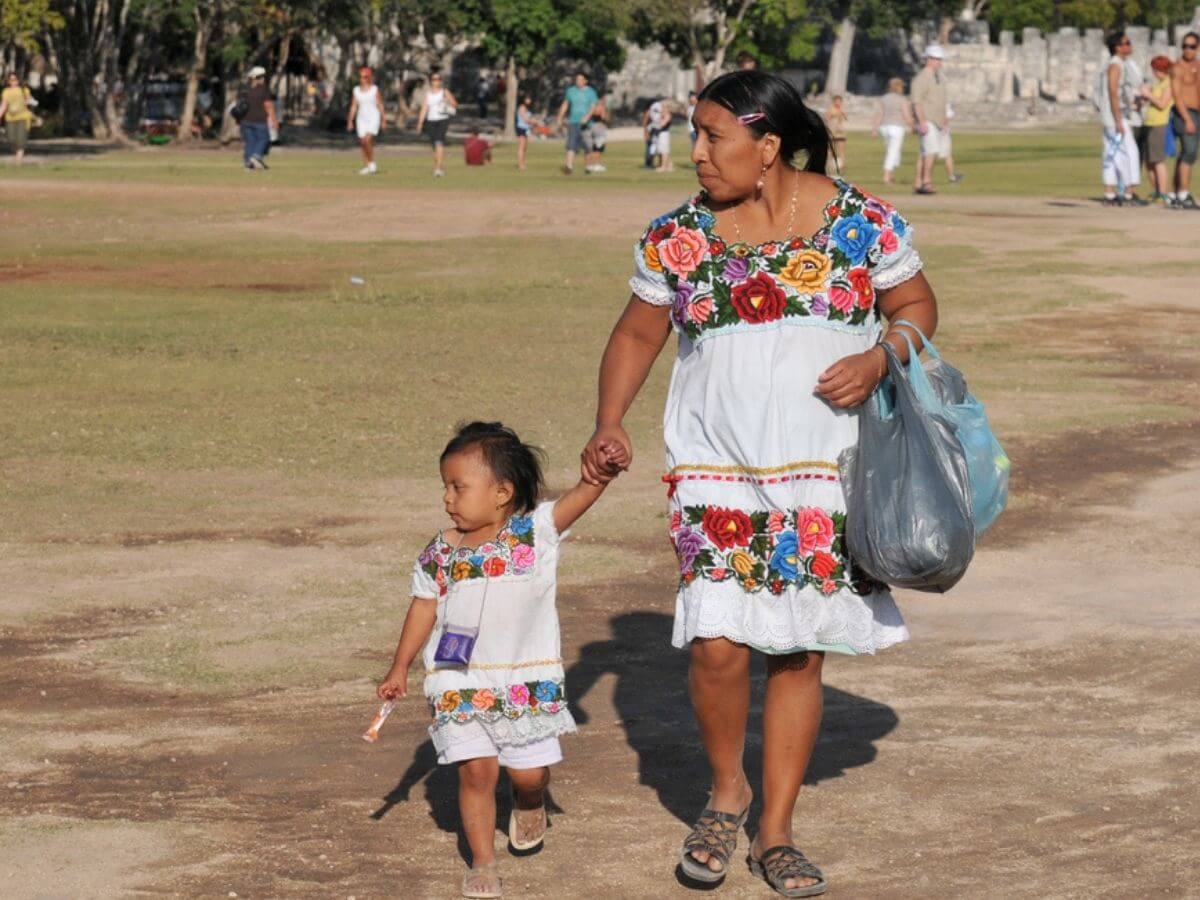
Today, the huipile remains the most popular female indigenous garment still in use and is commonly seen in the southern Mexican states including Chiapas, Yucatán, Oaxaca, Tabasco, Campeche and Veracruz. An authentic, full-length, hand-embroidered huipile is a collector’s item and can cost several hundred dollars. But, you can also find commercially made huipile tops in markets and souvenir shops for under 20 USD. These make great gifts and are some of my favorite things to send back to my nieces.
34. Hammocks (Yucatan)
Hammocks have been a part of the Yucatan’s cultural heritage for centuries, with origins dating back to the ancient Maya. The “Mayan weave” or “sprang weave” creates a supportive bed with good ventilation, providing a comfortable and practical solution for sleeping above the ground, away from insects and other potential threats. Traditionally, Yucatan hammocks were made from natural fibers like cotton or henequen.
Today, artisans may incorporate durable nylon which lasts longer. While traditional hammocks are often white or natural cotton, modern versions are available in vibrant colors and patterns reflecting the lively culture of the Yucatan. Today, the best quality hammocks are still woven by the people of the Yucatan Peninsula, often by the women of the family using vertical hand looms set up in their homes. It may take a few weeks to produce one high-quality, matrimonial-size hammock. The town of Tixkokob, near Merida, is particularly famous for its hammock makers. Merida and Valladolid have numerous shops and markets selling authentic Yucatan hammocks.
35. Rebozos (Michoacan)
An authentic rebozo from Mexico makes an incredibly versatile gift. A rebozo can be used as a shawl, scarf, baby carrier, or even a decorative piece. The designs and colors of rebozos often represent different regions or indigenous communities within Mexico. Rebozos are made and worn all over Mexico but some of the most sought-after come from Patzcuaro in Michoacan and Tenancingo in the state of Mexico.
Santa Maria del Rio in San Luis Potosi is often referred to as the “Cradle of the Rebozo” due to its long-standing tradition of rebozo weaving. A rebozo is one of the more unique things to get in Mexico and a practical souvenir to bring back home.
36. Guayaberas (Yucatan)
The Guayabera, often referred to as the “Mexican Wedding Shirt,” has deep roots in Latin culture, with its origins debated between Mexico and Cuba. This traditional shirt is characterized by its boxy shape, two vertical rows of closely sewn pleats and four pockets. Today, many Guayaberas have been designed to suit more modern tastes featuring a slimmer profile, omitting the pockets and adding color to the designs.
As the cultural heart of the Yucatán Peninsula, Mérida is arguably the best place to buy an authentic Guayabera. The city boasts numerous specialized boutiques where these shirts are handcrafted using traditional methods. “Guayaberas Jack” is one of the most popular with locals and visitors alike. If you find yourself anywhere in Mexico with a Liverpool department store, they carry gorgeous and stylish Guayabera shirts from a company called “Abita”. This is what we buy when the boys have a special event that calls for a special shirt.
37. Traditional Cooking Items (Various Regions)
Some of the most unique things to get in Mexico are traditional Mexican cooking utensils and other everyday kitchen items. One of the most interesting is the molinillo, an interesting wooden whisk used specifically to make Mexican hot chocolate. This is something truly unique to Mexico and a great souvenir, especially for chefs or foodies.
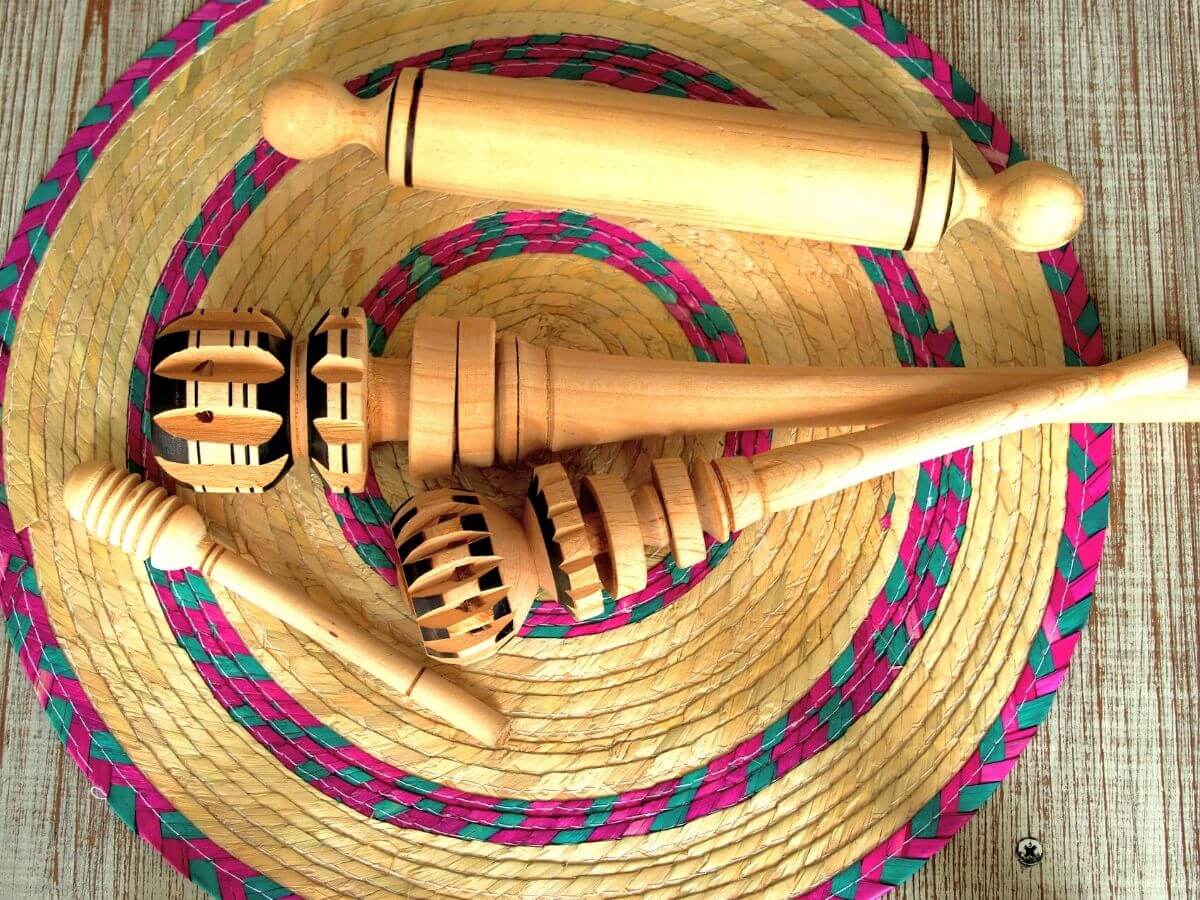
Wooden spoons and serving utensils are commonly found in local markets all over Mexico. They are hand-carved, sanded until smooth and then stained and sealed with a food-safe varnish. You can find beautiful bowls, cutting boards, salad servers and utensils of all types and sizes. Fun Fact: If you are planning to bring back any Melipona honey, be sure to pick up some small wooden spoons. This highly sought-after medicinal honey should never be served with a regular metal spoon.
38. Hand Painted Converse Sneakers from Pintando Pasos (Mexico City)
The Pintando Pasos collaboration began in 2004 when a group of traditional gourd carvers in Oaxaca teamed up with Converse to create a sustainable business to promote the culture of their village and its artistic tradition. Since then, the creativity of the Oaxacan artisans has been recognized worldwide as sales of these sneakers reached the global market.
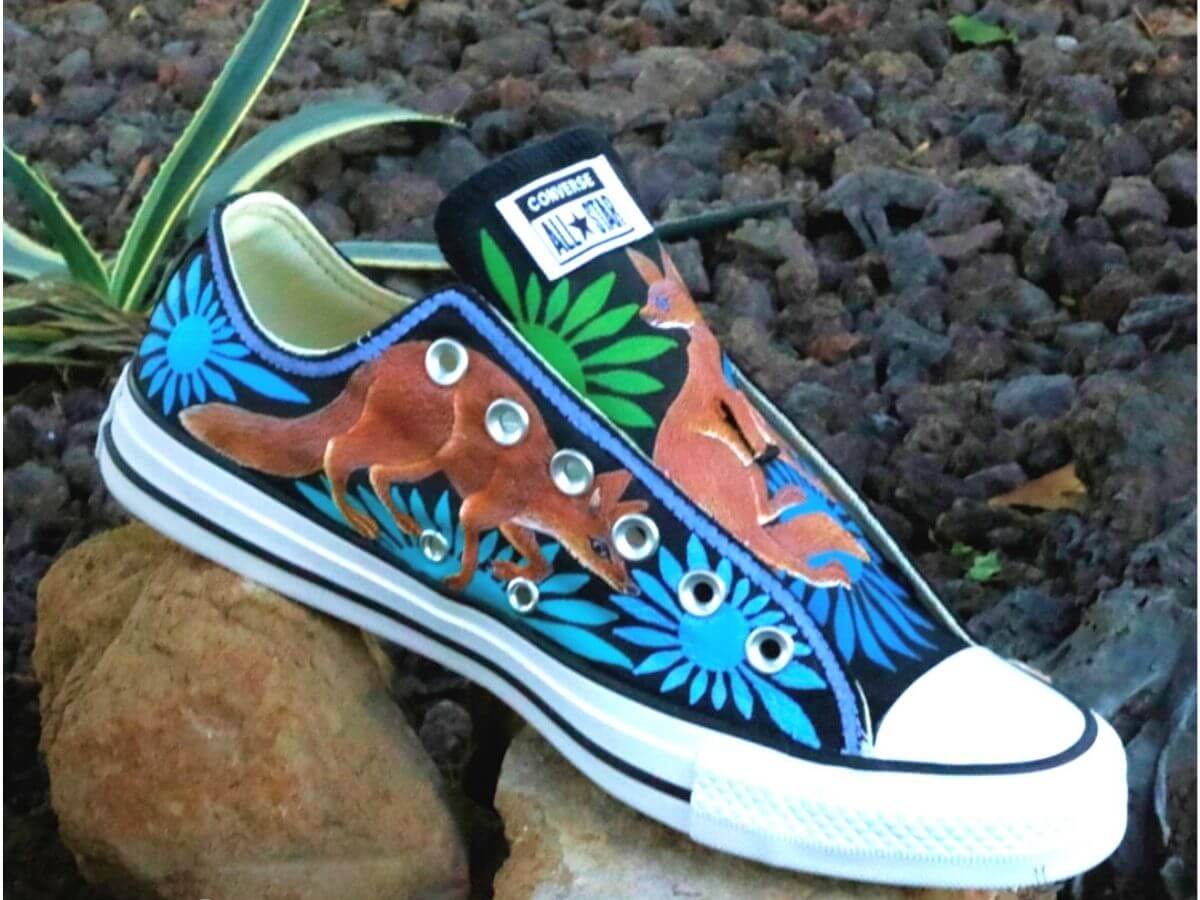
Each hand painted pair of sneakers is signed by the artist and comes with a certificate of authenticity. Converse donates the raw materials for this project and 100% of the sales go directly back to the Mixteca de Pinotepa de Don Luis community in Oaxaca. You can now find these kicks online but it would be much cooler to pick up a pair in Mexico City.
39. Hand-blown Glassware (Various regions)
Mexican hand-blown glassware makes a colorful and practical gift to bring home. It is sturdy and can be transported in your suitcases, cushioned by your clothes. Tonalá and Tlaquepaque near Guadalajara are famous for their artisanal crafts, including handblown glass. Guanajuato has a rich tradition of glassblowing, and you can find beautiful pieces in local markets and shops. Baja California, especially around Ensenada, has several glassblowing studios where visitors can watch artisans at work and purchase their creations.
Here in Playa del Carmen, we have a very well-known glassblowing studio. You can see their glassware used all over the Riviera Maya in hotels and restaurants as well as for sale in souvenir shops and boutiques. The actual workshop is a bit off the beaten path but a taxi driver can get you there.
40. Mexican Sports Memorabilia (Various regions)
If you have friends or family members who are sports fans, a futbol (soccer) jersey from one of the country´s top teams is a great gift to bring back from your trip to Mexico. They are easy to find in most metropolitan areas and popular tourist destinations. If you can, look for an official jersey for one of the “Big Four” teams, Club América, Guadalajara (more commonly known as Chivas), Cruz Azul and Pumas UNAM.
If you have any F1 racing fans back home, anything celebrating Mexico´s top F1 driver, Sergio “Checo” Perez and the Red Bull racing team would make a great gift. Checo is originally from Guadalajara so, as you can imagine, you can find authentic licensed items there.
41. Cowboy Boots (León, Guanajuato)
Cowboy boots are one of the best things to get in Mexico especially if you are visiting the state of Guanajuato. Leon is renowned for its leather goods, and cowboy boots are no exception. The city has a long tradition of boot-making, with skilled artisans employing both traditional techniques and modern designs to create high-quality, durable boots that feature unique designs, intricate stitching, embroidery, and inlaid leatherwork.
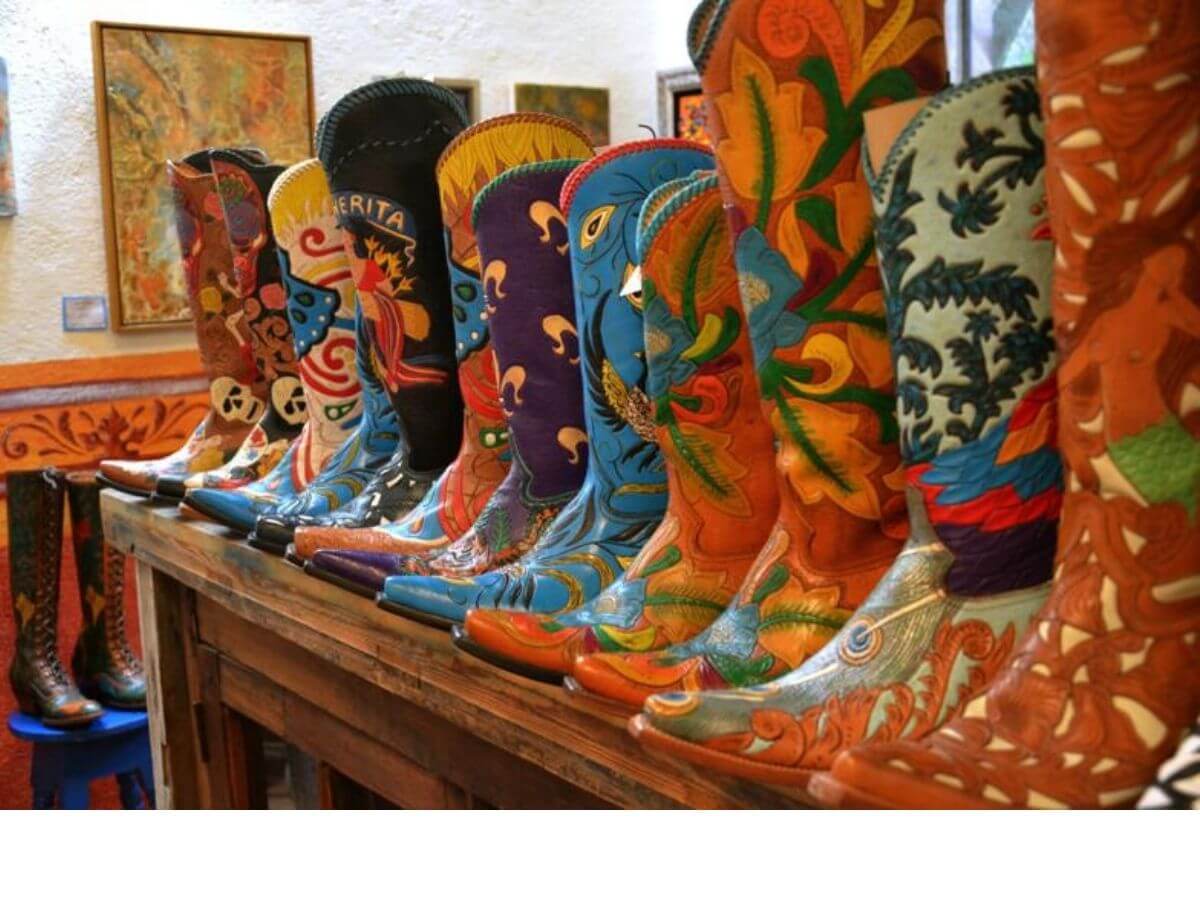
The place to shop for Mexican cowboy boots is the Zona Piel (leather zone) and the Mercado de Calzado y Piel both of which offer numerous shops and boutiques specializing in leather goods, including cowboy boots. Here you can find workshops that will tailor make a pair of boots just for you! One of the best makers of Mexican cowboy boots is Botas Cuadra who create highly sought-after boots, belts, bags and other accessories from exotic leathers such as lizard, crocodile, python, ostrich and deer. A pair of boots like this will set you back several hundred dollars but will last you a lifetime.
Finding the Best Mexican Souvenir from Your Mexican Adventure
As you can see, there are so many remarkable and interesting things to get in Mexico if can look past the “typical Mexican souvenirs”. Pass by the sombreros and fake Mexican blankets, the magnets, shot glasses and the “3 x 10 USD” t-shirts and you can find some great gifts that are authentically Mexican.
Even if you are in a super touristy area like Cancun, you can find something unique to bring home. Because the art and handcrafts from Mexico are so well-known and sought after, galleries and fine specialty shops in popular travel destinations all over Mexico bring in pieces to serve the demand of discerning shoppers and collectors.
Here´s a handy tip to leave you with. If you are flying in and out of the Cancun International Airport, the souvenir shops in the airport near the gates actually have a wide variety of authentic Mexican art and handcrafts, at reasonable prices from all over the country. So, if your Mexico travels didn´t take you everywhere you wished to go, you can still bring home a high-quality souvenir that is authentic to this culturally diverse country.
In the end, the best things to get in Mexico are the ones that have been specifically chosen to please a particular person. Look for something to take back to a loved one that speaks to who they are and where their passions lie.
